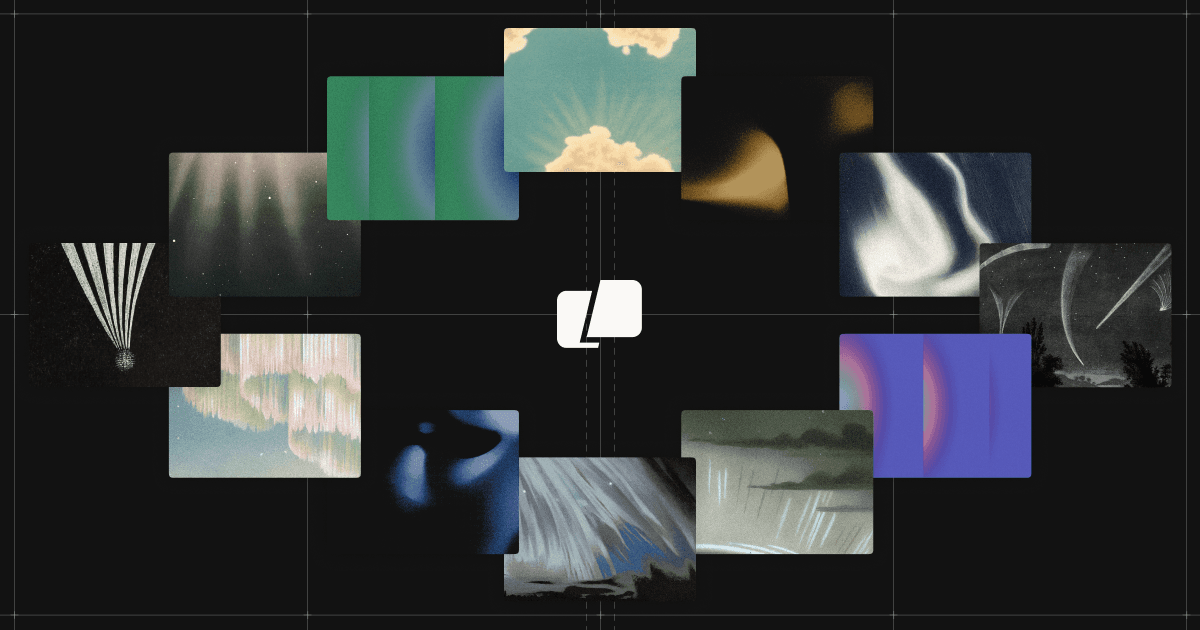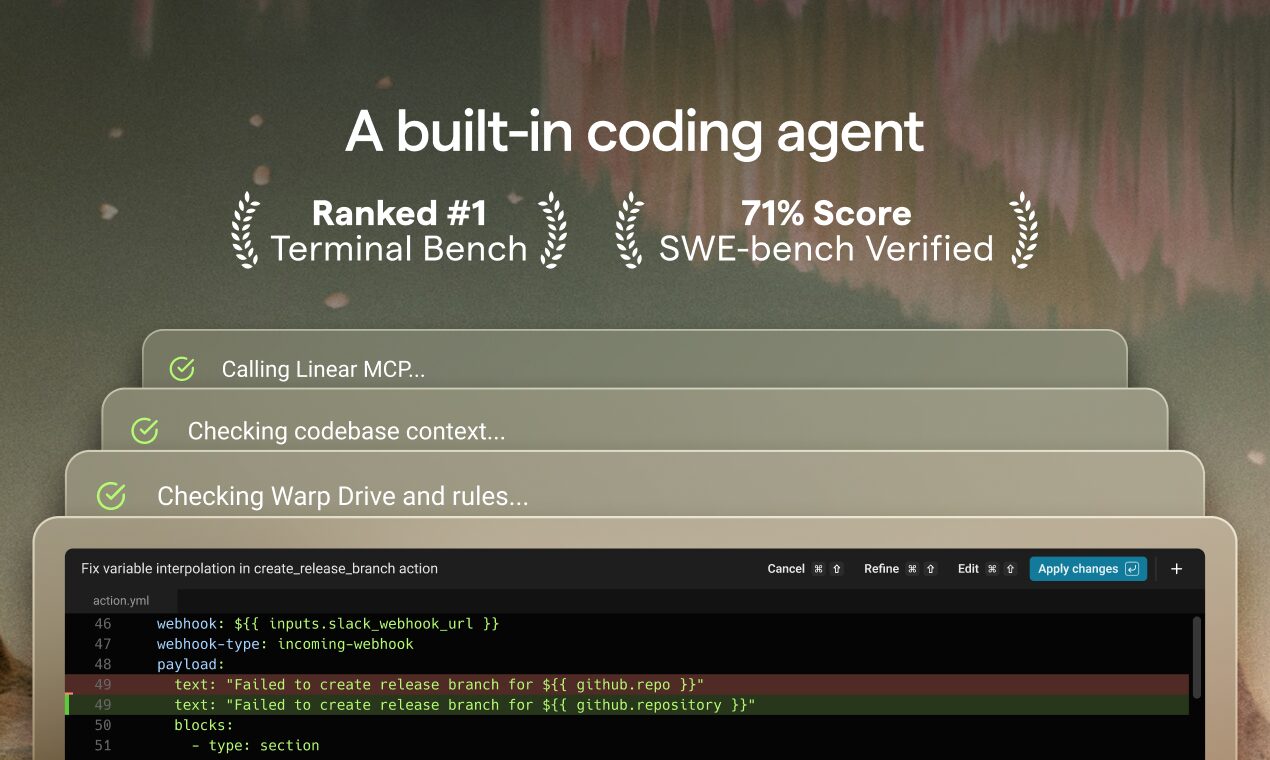
Table of Contents
Overview
Warp 2.0 represents a revolutionary evolution in terminal technology, transforming from a traditional command-line interface into a sophisticated, AI-powered development environment. Built with Rust and leveraging GPU acceleration, Warp 2.0 is designed for modern development workflows including multi-threaded coding, complex deployment tasks, and AI-assisted debugging. The platform has demonstrated exceptional performance in industry benchmarks, achieving an impressive 71% score on SWE-bench Verified and securing the top position on Terminal-Bench with 52%, establishing its leadership in real-world development scenarios.
Key Features
Warp 2.0 introduces groundbreaking capabilities that redefine terminal interaction and developer productivity:
- Multi-threaded agent execution: Run multiple AI agents concurrently to handle different development tasks simultaneously, improving efficiency and workflow organization.
- AI-powered development assistance: Leverage intelligent agents for code generation, error debugging, log analysis, and automated deployment pipelines through natural language interactions.
- Superior benchmark performance: Proven excellence on industry-standard evaluations including SWE-bench Verified and Terminal-Bench, ensuring reliable performance for demanding development tasks.
- Block-based command organization: Navigate and manage commands through intuitive input-output blocks that can be shared, searched, and organized for enhanced productivity.
- Universal command palette: Access commands, workflows, notebooks, and settings through a powerful, searchable interface that minimizes cognitive overhead.
- Rich multimedia support: Enhanced terminal experience with support for images, rich text formatting, and interactive graphics for better information visualization.
How It Works
Warp 2.0 integrates a modern terminal interface with intelligent AI agents to create a comprehensive development environment. Users interact through a universal input that accepts both natural language prompts and traditional terminal commands. The multi-agent architecture enables parallel task execution with real-time feedback and context awareness. AI agents continuously provide intelligent suggestions, automate repetitive workflows, and offer visual tools that simplify complex development processes, transforming the traditional command-line experience into an intuitive, agent-driven workspace.
Use Cases
Warp 2.0 excels across diverse development scenarios:
- AI-enhanced terminal workflows: Ideal for developers seeking an optimized, high-performance environment with intelligent assistance built directly into the terminal experience.
- Automated debugging and troubleshooting: AI agents rapidly identify issues, suggest solutions, and automate fix implementations, significantly reducing development time.
- Complex deployment orchestration: Manage and automate sophisticated deployment sequences with AI guidance, ensuring consistency while minimizing manual intervention.
- Collaborative development: Share terminal sessions, commands, and workflows with team members through integrated collaboration features.
Pros \& Cons
Advantages
- Exceptional performance: Delivers outstanding speed and responsiveness through GPU acceleration and Rust-based architecture.
- Intuitive modern interface: Provides a user-friendly experience that bridges traditional terminal power with contemporary UX design.
- Advanced workflow capabilities: Handles sophisticated multi-step development processes with AI assistance and automation.
- Industry-leading benchmarks: Demonstrates superior performance in standardized developer productivity assessments.
- Cross-platform availability: Now supports macOS, Linux, and Windows, providing a consistent experience across operating systems.
Disadvantages
- Learning curve for advanced features: Users may need time to fully utilize AI integration and advanced workflow capabilities.
- Internet connectivity requirement: Some AI features require an active internet connection for optimal functionality.
- Resource overhead: More memory and processing intensive compared to minimal terminal emulators.
How Does It Compare?
・Traditional terminals like iTerm2 provide solid functionality but lack integrated AI capabilities and advanced workflow management.
・Ghostty offers excellent performance with a Rust-based architecture, focusing on raw speed but without comprehensive AI integration or collaboration features.
・Kitty delivers GPU acceleration, scripting via Python, and rich feature sets (tabs, layouts, inline images), yet does not include agent-driven or natural-language workflows.
・WezTerm combines GPU rendering with Lua-based configuration and built-in SSH support, but lacks integrated AI agents and workbench-style interfaces.
・Alacritty excels in minimal, GPU-accelerated performance and low resource usage but remains a bare-bones emulator without development workspace features.
・Hyper uses web technologies for cross-platform compatibility and extensibility via plugins, yet cannot match Warp’s native performance or AI-powered workflows.
・Warp 2.0 uniquely unites high-performance terminal functionality with AI-driven agents, multi-threaded task execution, and collaborative features, creating a true agentic development environment.
Final Thoughts
Warp 2.0 transcends the boundaries of a conventional terminal by integrating multi-threaded capabilities, intelligent AI agents, and a highly intuitive interface. With cross-platform support on macOS, Linux, and Windows, it empowers developers to dramatically boost productivity and streamline workflows. While it introduces a learning curve and requires internet connectivity for AI features, its unparalleled performance, comprehensive feature set, and agent-driven approach make Warp 2.0 an indispensable tool for modern software development.

